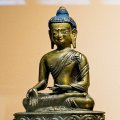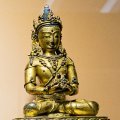Patan Museum (Nepal): photo 108
Photo 108 of 212 in Gallery: Patan Museum (Nepal)

Image title: Akshobhya and the Five Buddhas
Description of the photo
(a) A Copper sculpture of a Nimbus with Five Buddhas, from the 17th/18th century origination from Nepal.—Materials used: Copper repoussé, gilt, paint.
Description: The Five Buddhas are arranged here on a repoussé nimbus (prabhamandala) for an image now missing. Clockwise from top are Amitabha/Amitayus, Vairochana, Ratnasambhava, Amoghasiddhi (with his hand poses reversed), and Akshobya.
Notes: The Five Buddhas are fundamental to the doctrines of Mahayana and Vajrayana Buddhism. They are also known as Jinas (conquerors), Tathagatas (Buddhas), and Transcendent/Dhyani (meditation) Buddhas. Often they are arranged around stupas and chaityas according to the directions they oversee.
(b) A Bronze sculpture of Akshobya or Akshobhya, from the 12th century origination from Nepal.—Materials used: Bronze, gilt, silver and copper inlay.
Description: East-facing Akshobhya (“The Imperturbable”) is important as the carrier of the thunderbolt (vajra), the primary symbol of later Buddhism. Without the vajra, the image would be identified as Shakyamuni.
Gallery information:
The Patan Museum is located on the Durbar square of Patan (Lalitpur/Lalitapura, Kathmandu, Nepal) which is associated Keshav Narayan Chowk (Keshavnarayan)—a form of Lord Vishnu. Being listed as a World Heritage Site, the whole of Durbar square is filled with exquisite temples, sculptures and other ancient structures, of which the ancient history history can be traced to the Malla Kings of Lalitpur. It is an important site for both Buddhism and Hinduism.
Photo details:
Date: 2019-12-02
Camera: SONY ILCE-6400
Exposure: 1/15
Aperture: f/4.5
ISO: 100
Focal length: 18mm
High resolution:
Download file
Size: 1.64 MB
Resolution: 1194 x 1784
© Photograph by Gabe Hiemstra.
License: CC BY-NC-ND 4.0

